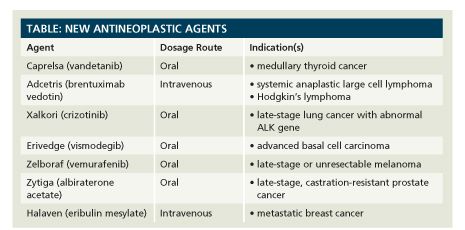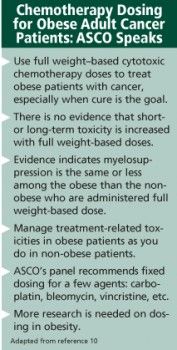Targeted Therapies in Cancer: New Drugs, New Dosing
New antineoplastic agents approved by the FDA for a variety of cancers advance drug therapy as more research spurs the fast pace of change in oncology.
New antineoplastic agents approved by the FDA for a variety of cancers advance drug therapy as more research spurs the fast pace of change in oncology.
“Targeted therapy” is all the buzz in oncology circles lately. Targeting tumors at cellular levels creates more effective therapies—often with fewer side effects than traditional treatments—and allows trials to progress more quickly. Reinforcing this trend, the FDA approved several effective new antineoplastic agents in the last year. (See table below.) Additionally, the American Society of Clinical Oncologists (ASCO) has published much-needed guidelines to answer a persistent, puzzling question: Should we dose-reduce when the patient is obese or increasingly, grossly obese?
Orphan Diseases, Growing Attention
The FDA gives the “orphan” designation to diseases that are currently untreatable or affect fewer than 200,000 people in the United States. Patients with these diseases often have trouble being accurately diagnosed and appropriately treated. In the last few years, the FDA encouraged manufacturers to develop products that diagnose and treat orphan diseases, with encouraging results: the agency approved 10 new drugs for orphan diseases in the last 18 months. Among them are 3 antineoplastics:
Caprelsa (vandetanib) is the first drug approved to treat rare medullary thyroid cancer. It affects fewer than 2200 Americans annually, and can occur spontaneously, or as a genetic syndrome. Caprelsa may alter cardiac electrical activity, leading to arrhythmias and sudden death, and it was approved with a REMS program.1
Adcetris (brentuximab vedotin) is the first drug to treat systemic anaplastic large cell lymphoma (ALCL; 50,000 cases annually). ALCL may appear in the lymph nodes, skin, bones, soft tissue, lungs, or liver. Adcetris is also the first FDA-approved agent for Hodgkin’s lymphoma (approximately 10,000 cases annually) since 1977. Adcetris has a black box warning for viral infection and death. Side effects may include neutropenia, peripheral neuropathy, fatigue, nausea, anemia, upper respiratory infection, diarrhea, fever, cough, vomiting, and thrombocytopenia.2
Approved for the few patients—less than 7% of lung cancer patients—who have late-stage lung cancer and an abnormal ALK gene, Xalkori (crizotinib) has a companion genetic test, the Vysis ALK Break Apart FISH Probe Kit. Appropriate patients are usually nonsmokers. The FDA approved Xalkori under its accelerated approval program using tumor shrinkage as the surrogate end point for survival. Its safety issues include pneumonitis, vision disorders, nausea, diarrhea, vomiting, edema, and constipation.3

Skin Cancers
Basal cell carcinoma (BCC), the most common skin cancer, grows slowly and is often—but not always—curable. Approved under expedited review, Erivedge (vismodegib) is approved for advanced or metastatic BCC and is administered orally, once daily. Erivedge’s target is the Hedgehog pathway. Erivedge shrank lesions in 43% of patients with locally advanced BCC and in 30% of patients with metastatic BCC. Side effects include muscle spasm, alopecia, weight loss, and distorted smell or taste. Its label includes a black box warning for 2 potential risks: death and severe birth defects.4
The FDA also approved Zelboraf (vemurafenib) and companion genetic test for late-stage or unresectable melanoma, the leading cause of death from skin disease. It is also the first in a new class of drugs, and only the second agent ever (after Yervoy, March 2011) to improve overall survival. In its pivotal study (N = 675 patients with late-stage melanoma with the BRAF V600E mutation who had not received prior therapy), median survival for Zelboraf-treated patients was not reached (77% were alive), compared with a median survival for comparator dacarbazine of 8 months (64% still living). A companion diagnostic test, Cobas 4800 BRAF V600 Mutation Test, is needed to identify appropriate patients. Safety concerns include development of cutaneous squamous cell carcinoma in about onefourth of patients; it is managed with surgery. Other common side effects include joint pain, rash, alopecia, fatigue, nausea, itching, and photosensitivity.5
Cancer by Gender

Prostate cancer, the most common cancer in men, follows lung cancer in number of deaths. Zytiga (albiraterone acetate) is the first in a new class of drugs to treat late-stage, castration-resistant prostate cancer. Given with prednisone, Zytiga was shown to prolong survival in certain patients, adding a new approach to sparse treatment options. In its pivotal trials (N = 1195 patients with late-stage castrationresistant prostate cancer who had received prior docetaxel), patients who received Zytiga and prednisone survived about 4 months longer (14.8 months) than those on placebo and prednisone (10.9 months). Its approval was based on early (interim) findings. Side effects include joint or muscle discomfort, hypokalemia, edema, hot flashes, diarrhea, urinary tract infection, cough, hypertension, arrythmia, urinary frequency, nocturia, gastrointestinal upset, and upper respiratory tract infection.6
Among women, breast cancer is the second-leading cause of cancer-related deaths. The FDA approved Halaven (eribulin mesylate) for metastatic breast cancer after treatment with at least 2 other chemotherapeutic regimens has failed. Tested in 762 women, it extended life an average of 2.5 months compared with alternatives. Halaven is the first single agent to show an overall improvement in survival. Reported side effects include neutropenia, anemia, leukopenia, alopecia, fatigue, nausea, asthenia, peripheral neuropathy, and constipation.7
Another Kidney Approach
With 6 agents approved for renal cell carcinoma (RCC) since 2005, Inlyta (axitinib) is a new option, approved in January 2012. In its pivotal trial (N = 723 patients with 1 prior systemic therapy whose disease had progressed), axitinib-treated patients had a median progression-free survival of 6.7 months compared with 4.7 months with sorafenib. Common side effects observed included diarrhea, hypertension, fatigue, anorexia, nausea, dysphonia, palmar-plantar erythrodysesthesia, weight loss, vomiting, asthenia, and constipation.8
ASCO Speaks: Obesity
With two-thirds of Americans now overweight or obese, clinicians have concerns about dosing by weight or body surface area when the patient’s BMI is >25.9 An ASCO panel has answered 6 clinical questions related to this topic in its new guideline, Appropriate Chemotherapy Dosing for Obese Adult Patients with Cancer, available at http://jco.ascopubs.org/.10 See the sidebar for key findings.
Ms. Wick is a visiting professor at the University of Connecticut School of Pharmacy and a freelance writer from Virginia.
References
1. Caorelsa [package insert]. Wilmington, DE: AstraZeneca Pharmaceuticals LP; 2011.
2. Adcetris [package insert]. Bothell, WA: Seattle Genetics; 2012.
3. Xalkori [package insert]. New York, NY: Pfizer Labs; 2012.
4. Erivedge [package insert]. San Francisco, CA: Genentech; 2012.
5. Zelboraf [package insert]. San Francisco, CA: Genentech; 2011.
6. Zytiga [package insert]. Horsham, PA: Janssen Biotech, Inc; 2012.
7. Halaven [package insert]. Woodcliff Lake, NJ: Eisai Inc; 2012.
8. Inlyta [package insert]. New York, NY: Pfizer Labs; 2012.
9. Centers for Disease Prevention and Control. Adult obesity facts. www.cdc.gov/obesity/data/adult.html. Accessed May 1, 2012.
10. American Society of Clinical Oncology. Appropriate Chemotherapy Dosing for Obese Adult Patients With Cancer: American Society of Clinical Oncology Clinical Practice Guideline. http://jco.ascopubs.org/content/30/13/1553.full?sid=9c10c0e5-0a4d-4f6c-bf8a-7290070d67ed. Published April 2012. Accessed May 1, 2012.

